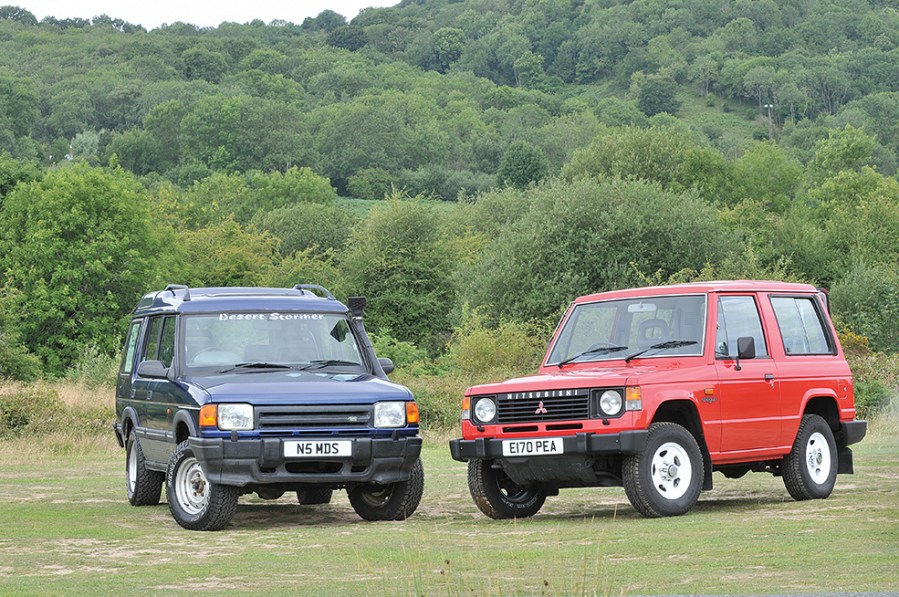As the Mitsubishi Shogun disappears and the firm’s future in Europe looks uncertain, we revisit the vehicle which had Land Rover on the run to find out which is best today.
Words & Photos by Paul Wager.
As I began typing this feature I received an email trumpeting the latest Alpina-tweaked version of BMW’s biggest 4×4, the X7 which is both monstrously polluting and embarrassingly thirsty in an automotive world frantically trying to electrify itself. It does however illustrate perfectly the love of high-riding premium 4x4s among the buying public, from Audi’s Q range right up to the king of them all, the Range Rover.
Despite the growing number of SUVs around though, it’s suddenly become all but impossible to buy a genuine multi-purpose all-wheel drive vehicle which offers both everyday family practicality and genuine off-road capability. Daihatsu left these shores many years ago now, Suzuki has just announced the end of the Jimny in the UK and those wanting to tow 3.5 tonnes but not wanting to pay Range Rover or Discovery prices for the privilege will be mourning the loss of the Shogun.
Ironically, it was the Shogun which prompted the development of the Discovery by Land Rover in the first place and with this in mind, it seemed appropriate to bid the Mitsubishi Shogun farewell by sampling the first generation and comparing it to the original Discovery.
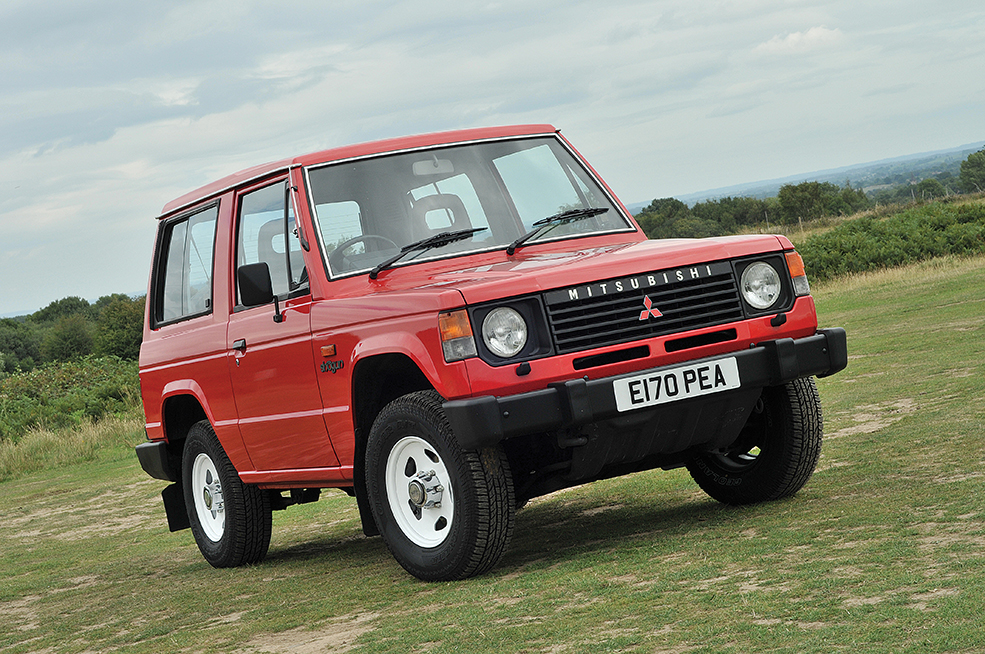
Mitsubishi Shogun
Although the Shogun (or the Pajero as it was known at home) would have the Solihull chaps on the run when it arrived in the UK, it’s unlikely that the development team at Mitsubishi’s Sakahogi plant had Land Rover in their sights at all. Rather the Shogun was conceived more as a rival to the Toyota Land Cruiser, offered initially only in short-wheelbase three-door form and with the option of a canvas roof. This was by no means the first 4×4 from Mitsubishi, the firm having made its first prototype off-roader, the PX33 as far back as 1934.
Using a separate chassis, it was noticeably less crude than the Land Rover and featured some of the slightly quirky touches for which Mitsubishi has always been known.
As launched in the UK in 1982, the Mitsubishi Shogun was initially powered by a choice of four-cylinder engines including the firm’s Astron II 2.6-litre petrol and later the 2.3-litre diesel. The petrol engine was unusual in boasting a larger than normal capacity for a four-pot design, its operation smoothed out by the use of twin balancer shafts.
Its underpinnings also display similar innovative thinking, the Shogun employing independent front suspension by torsion bars and double wishbones, with a live rear axle suspended by leaf springs. The transmission mirrored the layout found in earlier Land Rovers, being a part-time four-wheel drive system with separate low-range, which was designed to run in rear-wheel drive in everyday use, with four-wheel drive available in either high or low range. Automatic locking hubs on the front wheels mean the driver doesn’t need to get out of the car to switch from two to four-wheel drive, merely coming to a brief halt to move the selector lever.
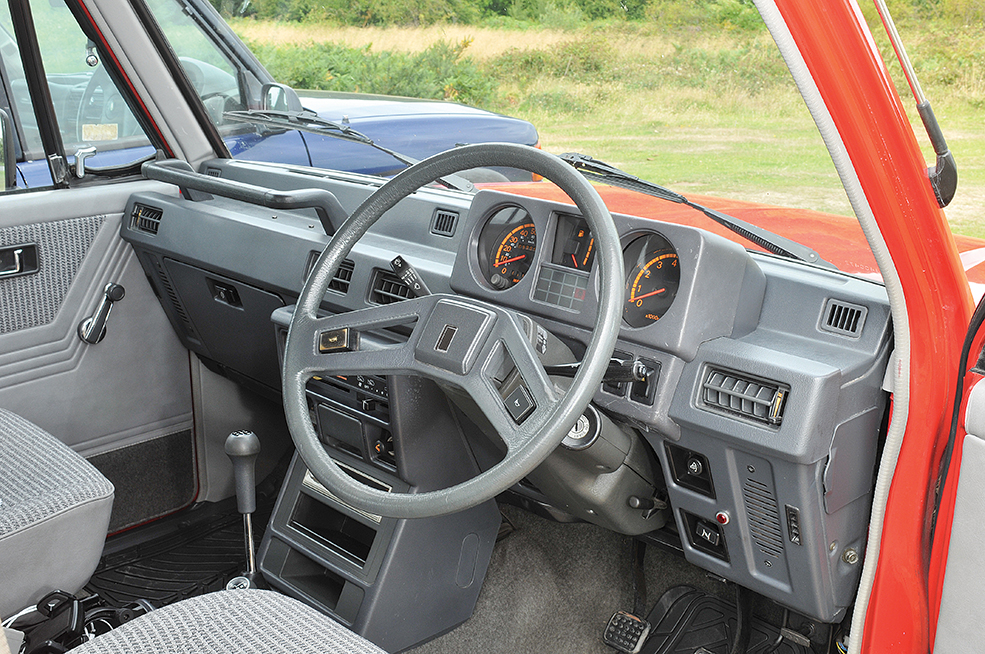
The Mitsubishi Shogun became a popular choice in the UK, offering a blend of comfort and capability which few others could match at the price. When the long-wheelbase version arrived in 1983, it brought with it a coil-sprung rear end offering an improved ride and crucially, no less than seven seats. Suddenly large families didn’t need to stick the spare pair of kids into rear-facing jump-seats in the boot of a Montego and the idea of the seven-seater quickly gained ground, taking Shogun sales with it.
A second generation arrived in 1991, with smoothed-over styling and the introduction of Mitsubishi’s Super Select transmission which allowed shifting between two and four-wheel drive on the move. By then, the Shogun had already moved up in the world with plush interior trim and a 3-litre V6 engine having been introduced back in 1988. For the Mk2 model, the diesel options expanded to include 2.5 and 2.8-litre units, while the petrol gained a new range-topping 3.5-litre V6.
The biggest change in the model’s lifespan came with the third generation introduced in 1999 which moved to a monocoque bodyshell with an integrated ‘chassis’ similar to the construction of the Discovery 3. The engine range remained similar in its mix of big-capacity four-pots and V6s, with the top-end 3.5 producing 203bhp.

In 2006 this would be mildly revised into the fourth and final generation which would update the car enough to make it competitive right until the end of UK sales in 2019, by which time no less than 114,164 examples had been sold here… plus of course countless grey imports over the years.
Despite these numbers, the original Mk1 Shogun is a rare beast indeed, their sheer utility meaning most were ground to dust towing and hauling over the years but Mitsubishi UK is proud of its heritage and recently acquired a pristine example of the first-generation model.
A 1987 model, it’s a perfect example of the original Shogun, a three-door petrol model resplendent in red and sitting on chunky white steel rims. Cloth-trimmed, it’s basic down to cloth seats, wind-up windows and a basic AM/FM radio and as such explains the appeal of the SUV perfectly: this wasn’t a status symbol, but a car for people who wanted to use it for practical stuff and be comfortable doing so, while also able to bowl along the motorway with a family on board.
Driving the Shogun for the first time, it’s easy to forget its age. Yes, the spindly ignition key is generic 1980s Japanese and details like the separate door locks betray the age of the design, but climb aboard and it all feels very modern – certainly compared to the agricultural cabin of a Land Rover which was its only British-built competition of the time.
Naturally, this lovingly preserved example fires instantly from cold, needing no attention from the manual choke and the first impression is simply how easy it is to drive. It’s here where the Mitsubishi Shogun won many friends, with the clutch and gearshift as light as any saloon car of the day, while standard-fit power steering makes low-speed driving a breeze.

Customers coming from a regular car back in the day would have felt right at home and the Shogun in practice was no more daunting to drive than a big estate car in the mould of the 200-Series Volvos. Contrast that with the intimidating Land Rover with its chunky welly-sized pedals, heavy steering and awkward gearshift and it’s easy to see why a new breed of vehicle was created both around the world and closer to home in Solihull.
This example uses the 2.6-litre Astron engine and despite a 91.1mm bore and 98mm stroke it’s surprisingly smooth thanks to those twin chain-driven balancer shafts. On first acquaintance it feels like a quietly muscled slugger of an engine, giving the Shogun respectable if not sparkling performance. But after a few miles I realise that the car has an unusually long throttle pedal travel similar to older Mercedes and using the full travel reveals the Shogun to be surprisingly lively.
The redline is marked at 6500rpm which would push my mechanical sympathy rather too far in a nice example like this, but certainly the big four-cylinder allows the car to be driven with some verve and it can easily hold its own in traffic.
At higher speeds, there’s nothing so old-fashioned as an overdrive of course; this being a Japanese car, you got a standard-fit five-speeder and it’s happy to bowl along the motorway at the legal limit, ultimately topping out at 87mph according to the brochure. It’s surprisingly stable at this speed too, despite the short wheelbase although the suspension does impart a somewhat choppy ride which was smoothed out in the long-wheelbase models with their coil-sprung rear.
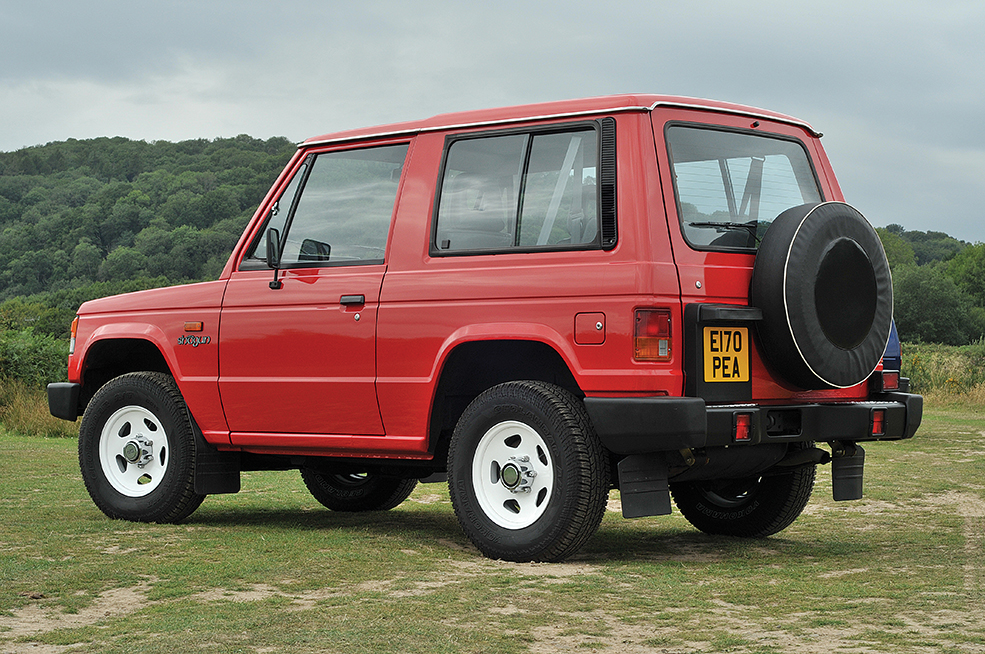
Off road, the Mitsubishi Shogun is legendarily capable, although our experience with the car didn’t extend beyond venturing on to a grassy common for photos since I really didn’t want to be making that phone call to Mitsubishi asking where best to attach a winching rope…
Instead, I will merely remind you of the many victories the Shogun notched up in desert endurance rallies over the years, starting with a strong showing in the 1984 Paris-Dakar. Closer to home, they were regularly spotted with big horse boxes and plant trailers, this example rated at 3-tonnes towing capacity and the final models capable of towing 3.5 tonnes – one of the few to equal the Discovery.
After just a couple of days with the Mitsubishi Shogun, it was obvious just why the new wave of family-focused 4x4s became popular enough to kick-start an entire new market segment and the most significant illustration if this is the car it allegedly inspired: the Land Rover Discovery. How did Solihull’s riposte to the upstart compare?

Land Rover Discovery
One of the early UK-market advertisements for the Mitsubishi Shogun sums up Land Rover’s predicament perfectly: the double-page spread shows a Series 3 Land Rover on the left, a classic Range Rover on the right and in the centre the Mitsubishi, with the strapline “at last… a middle of the Range Rover”.
By the time the Shogun in our photos had left the Pajero Manufacturing Company, a flurry of belated investment had given the Range Rover all the improvements it had been crying out for over the years including four doors, a modern interior and automatic option. In the process, it had also moved upmarket to the point where most of its target market could no longer afford it and those wanting a genuinely multi-purpose vehicle weren’t after a plushly trimmed status symbol either.
In which case your Land Rover salesman would have been only too happy to direct you to the original Land Rover, which in 1983 had evolved into the coil-sprung 90 and 110 models but in all other respects was very similar to the 1940s original. Yes, the Land Rover could equal the LWB Shogun’s seven seats – and even offer a 12-seat option – but the driving experience was very different, especially to someone coming out of a regular family car.
None of this was lost on Land Rover management, which realised the company needed to act quickly to preserve its place in the market by creating a product to sit between the two. The slight issue however was the funding required to develop a new model from the ground up, which simply wasn’t available within cash-strapped Austin Rover at the time.
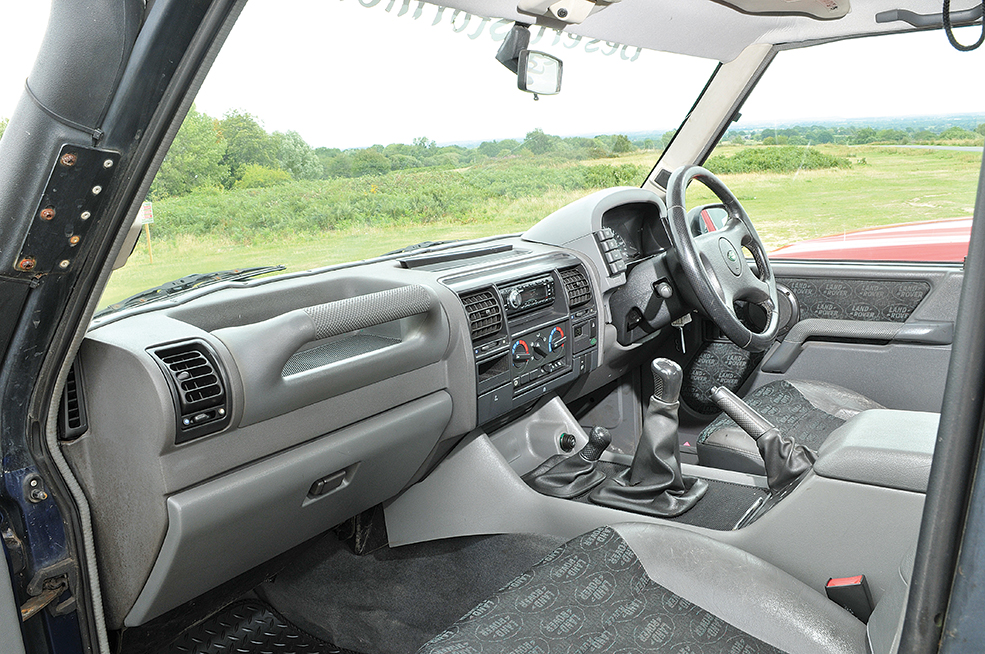
As it turned out though, clever lateral thinking meant a huge budget wasn’t needed anyway. Early on in the life of ‘Project Jay’ it was decided that the new model would use the 100-inch chassis of the Range Rover complete with that car’s bulkhead, doors and windscreen – the expensive bits. That the chassis was slightly longer than ideal was sidestepped by using the rear crossmember as effectively the rear bumper, something which was usefully assisted by the changing styling fashion dictating a shorter rear overhang.
Perhaps surprisingly, the development of a competitive diesel powertrain was initially considered more important than a seven-seat capacity and the result was the 200Tdi engine, an in-house Land Rover development which was well regarded for its longevity.
According to Land Rover insiders, the cost of the 200Tdi project nearly meant doing without the neat folding pair of rearmost seats, but luckily the popularity of the seven-seat Mitsubishi showed how crucial they were and they were duly added to the brief, in the process creating one of the Discovery’s enduring styling features in the raised roof necessary to create the required headroom. This had been necessary due to the position of the rearmost seats over the rear axle and rather than try to disguise the raised rear roof position, the stylists added the ‘Alpine windows’ to create a design feature.
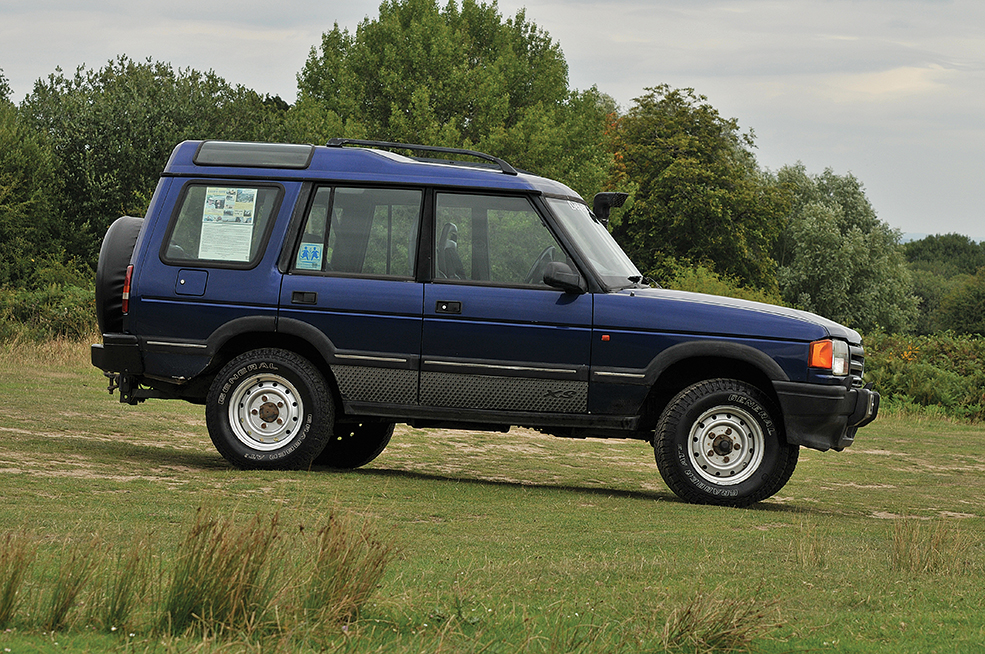
The first clay models were created in 1986 and the design was frozen in early 1987, with the distinctive interior created with input from Conran Design and cost-savings achieved by borrowing from across the Austin Rover empire: Rover 800 dashboard vents, Sherpa headlights and Maestro van tail lights.
Powered by the Rover V8 in carburetted 3.5-litre form and the 200Tdi diesel, the Discovery was launched in three-door form at the 1989 Frankfurt show, with the five-door version arriving in 1990 alongside fuel injection for the V8.
The Discovery proved to be a hit and before long was outselling both the Range Rover and the Land Rover, with many industry pundits having since suggested that without its existence Land Rover as a brand may not have survived.
The original design was updated in 1994 with a more conventional dashboard driven by the need to accommodate airbags for the US market and it’s one of these which we have here, thanks to diehard Land Rover fan Martin Smithson.
Chatting before the photo shoot, Martin was concerned that his well-worn Discovery might not be pristine enough next to Mitsubishi’s gleaming museum piece but in reality ‘Tasca’ as the vehicle is nicknamed, couldn’t be a better ambassador for the Discovery. Only a few years ago this Discovery was to be found up to its axles in sand and mud all over Africa and as he showed me photos of it wearing a big winch and ladder roof rack in the Tunisian desert it was hard to believe it’s the same vehicle.
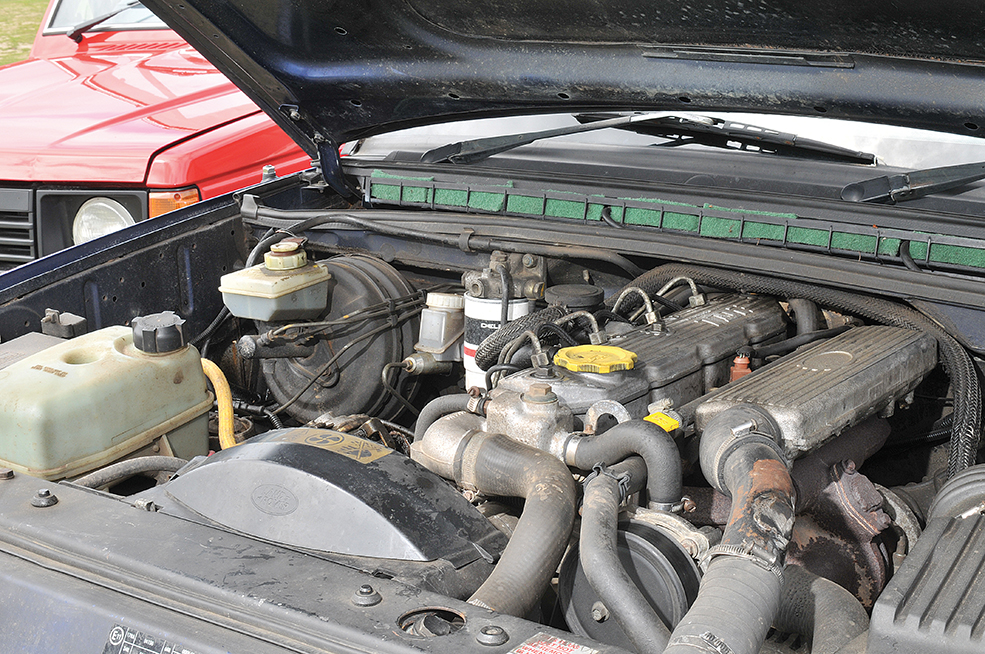
Now bereft of winch and roof rack, it’s been treated to some bodywork tidying and lives a more gentle life in semi-retirement in Worcestershire, but is still used as everyday transport by Martin, who clearly likes to have several Land Rover products on hand at all times: at his home in South Africa he has an air-portable Lightweight and has even penned a book on his Land Rover adventures, My Landy Life (available online via Amazon or at www.mylandylife.co.uk).
The requirements of social distancing prevented us from jumping from car to car on the day but I’ve covered thousands of miles in our own recently departed ’91 Discovery V8i and it’s a fascinating comparison with the Shogun.
In petrol form, the V8 Land Rover has the edge on refinement over the Mitsubishi four-pot, although later Shoguns turned this on its head with the V6. The diesels are more easily compared and in fact more similar, the direct injection Land Rover unit having a distinctly harder note.
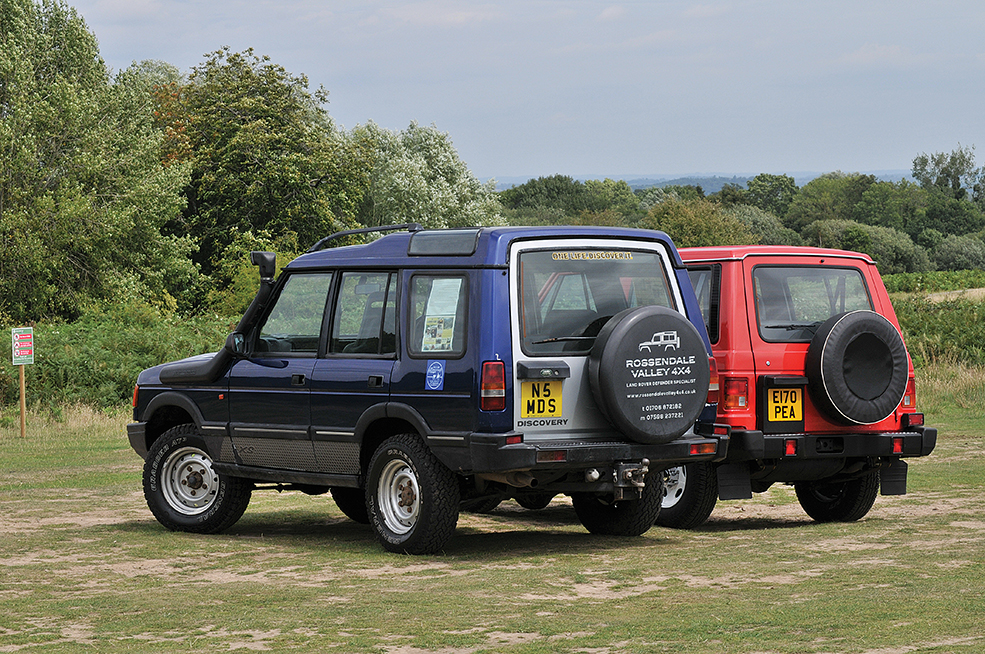
Martin’s is a post-facelift model without the Conran dashboard and Sherpa lamps but it’s identical underneath to the very earliest Discovery and as such is a fair comparison with the Shogun yet on the road it feels like the newer design despite its chassis dating from the Range Rover’s 1970s debut. The ride is vastly better and although it does lean in corners, the Land Rover actually has a less top-heavy feel, encouraging faster on-road progress – assisted ultimately by the Solihull product being permanent four-wheel drive.
Ultimately, it’s the more capable vehicle whether in Tdi or V8 form, although later generations of Shogun in long-wheelbase form would close this gap paper-thin… at which point the Japanese car’s price advantage also started to bite as Land Rover moved successive generations of Discovery further upmarket.
One thing’s for certain: as a knee-jerk reaction to an upstart threatening its market, the Discovery really was a mightily impressive response.
Meanwhile, any doubts about Land Rover reliability are certainly dispelled when looking over Martin’s much- travelled example which has simply shrugged off what sounds like a hard life.
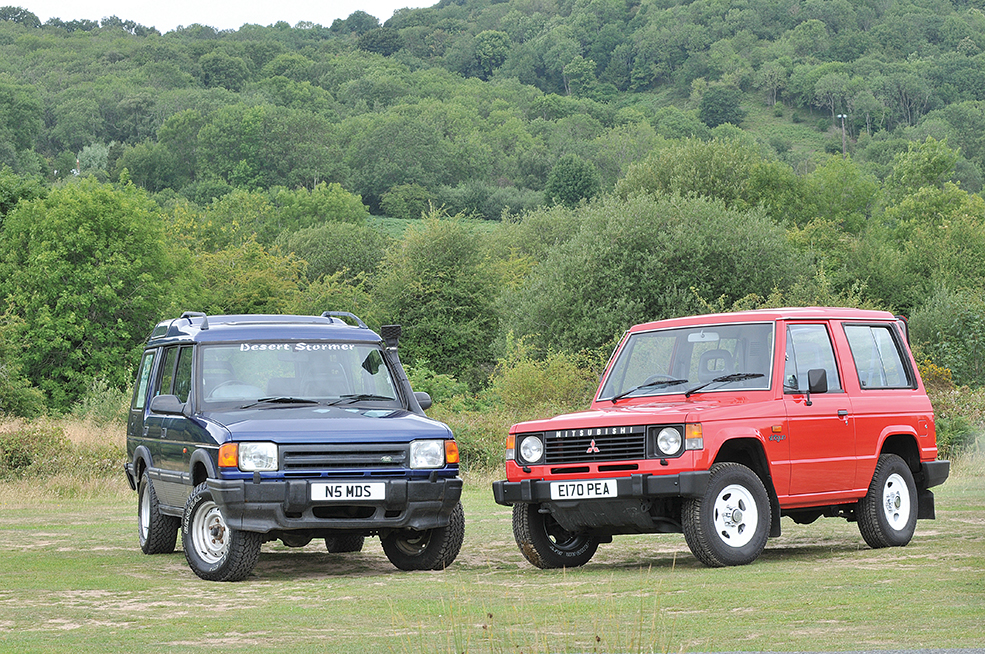
Verdict
As a classic today, an early Shogun like this is guaranteed to turn heads; you just don’t see them anymore, while the early ’90s Discovery is still a common sight in many rural areas, often with something very heavy on the tow hitch.
If it’s attention you want, then the Shogun is the winner and the big surprise is how well it drives in modern traffic and daily use. Its rarity though makes it the harder car to own, while of course part of the appeal of the Land Rover is the option of the V8 soundtrack.
There’s also virtually nothing you can’t buy for a Discovery of this vintage and as a result that makes it the perfect choice for the enthusiastic hands-on owner.

